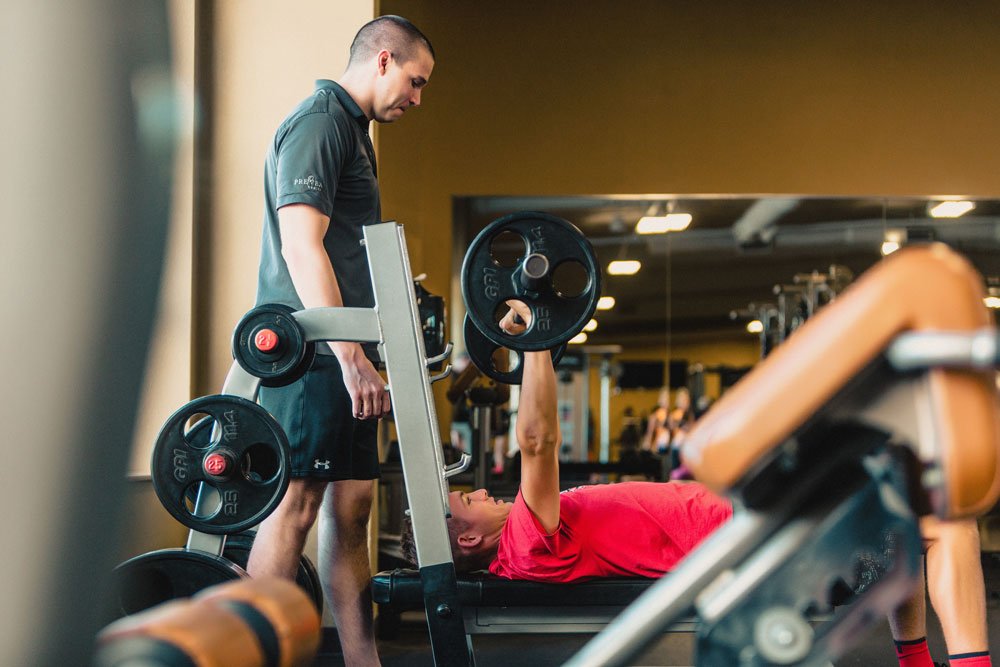Free weight exercises for beginners are an effective way to build strength and muscle. This article will provide a comprehensive guide to the best exercises for beginners using free weights, along with tips for proper form and technique.
Start your fitness journey off right with these foundational exercises that target major muscle groups and promote functional strength. Whether you’re looking to tone your arms, strengthen your core, or build lower body strength, free weight exercises are a versatile and accessible option for beginners.

Free Weight Exercises for Beginners
Benefits Of Free Weight Exercises
Engaging in free weight exercises offers various benefits to beginners, ranging from improved strength to enhanced stability and balance.
Improved Strength And Muscle Tone
Free weight exercises help beginners enhance their strength and muscle tone effectively.
Better strength and muscle tone lead to improved overall physical performance.
Enhanced Stability And Balance
Free weight exercises contribute to enhancing stability and balance for beginners.
Increased stability and balance aid in preventing injuries and improving posture.
Basic 30-Day Calisthenics Workout Plan for Beginners
Safety Tips For Beginners
Start your free weight exercises right with essential safety tips for beginners. Focus on proper form and start with lighter weights to avoid injury risks easily. Prioritize learning techniques before progressing to heavier weights.
Proper Form And Technique
To prevent injuries and maximize the effectiveness of your workout, it is crucial to maintain proper form and technique while performing free-weight exercises. Proper form ensures that you engage the correct muscles and reduces the risk of strains and sprains. It is recommended to familiarize yourself with the correct form for each exercise, and if needed, enlist the guidance of a qualified trainer for further assistance.
Start With Light Weights
When starting with free weight exercises, it is wise to begin with lighter weights. This allows your body to adapt to new movements and helps to develop the necessary strength and stability. Gradually increase the weight as you become more comfortable and confident with your form and technique. Remember, it’s better to start light and progress gradually rather than lifting too heavy and risking injury.
Essential Free Weight Exercises
When starting a strength training routine, incorporating Free Weight Exercises for Beginners is essential for building muscle and improving overall fitness. Free weight exercises help target multiple muscle groups, improve balance, and increase the effectiveness of your workouts. To help beginners get started, here are a few essential free-weight exercises to consider.
Squats
Squats of Free Weight Exercises for Beginners are one of the most effective full-body exercises that primarily target the quadriceps, hamstrings, and glutes. They also engage the core, lower back, and calf muscles, making them a great choice for beginners. To perform a squat, stand with feet shoulder-width apart, and lower your body as if you are sitting back in an imaginary chair, keeping your back straight and chest upright.
Bent-over Rows
Bent-over rows are an excellent exercise for targeting the back muscles, specifically the lats and rhomboids. This exercise also engages the biceps and forearms, making it a great compound movement for building upper body strength. To perform a bent-over row, stand with feet hip-width apart, bend at the waist, and keep your back straight as you pull the weight towards your lower chest.
Shoulder Press
The shoulder press is a fundamental exercise of Free Weight Exercises for Beginners for strengthening the deltoid muscles and improving overall shoulder stability. It also engages the trapezius and triceps, making it an effective upper-body exercise. To perform a shoulder press, stand with feet shoulder-width apart, and press the weights overhead while keeping your core engaged and avoiding arching your back.
Creating A Beginner’s Workout Plan
Creating a Beginner’s Workout Plan for Free Weight Exercises for Beginners involves thoughtful considerations, especially for those starting their fitness journey. This plan should incorporate free weight exercises tailored to a beginner’s needs, ensuring a gradual progression towards achieving realistic goals. By outlining a structured workout plan, beginners can effectively enhance strength, endurance, and overall fitness. Here’s a guide to help beginners create a workout plan emphasizing realistic goals and gradual progression.
Setting Realistic Goals
Before diving into a workout plan, it’s essential to set realistic goals. This could include aiming to increase strength, improve endurance, or work towards specific weight loss targets. Setting these goals for Free Weight Exercises for Beginners gives beginners a clear direction and motivation to persist in their fitness journey.
Gradual Progression
Gradual progression is crucial for beginners to prevent injuries and maintain motivation. By starting with lighter weights and gradually increasing the intensity, beginners can steadily improve their strength and endurance. Progressively introducing new exercises also helps in building a strong foundation without overwhelming the body.
Common Mistakes To Avoid
Newcomers doing free weight exercises in Free Weight Exercises for Beginners should avoid common blunders like incorrect form and excessive weight in Free Weight Exercises for Beginners. Make sure to start with light weights and focus on proper technique to prevent injuries and build strength effectively. Learning the basics first will ensure a solid foundation for your fitness journey. How to do a 30-minute keto?
Lifting Too Heavy Too Soon
One of the most common mistakes beginners of Free Weight Exercises for Beginners make when starting with free weight exercises is lifting too heavy too soon. It can be tempting to see how much weight you can handle right from the start, but this can lead to serious injuries. It’s important to remember that building strength and endurance takes time. Start with weights that you can comfortably handle and gradually increase the intensity as your body adapts.
When you lift weights that are too heavy for you, you put unnecessary strain on your muscles, joints, and connective tissues. This not only increases the risk of acute injuries but can also lead to long-term damage. It’s crucial to prioritize proper form and technique over the amount of weight you lift. By starting with lighter weights, you allow your body to get accustomed to the movements and gradually build up your strength.
Ignoring Warm-up And Cool-down
Another common mistake in Free Weight Exercises for Beginners that many beginners make is ignoring the warm-up and cool-down phase of their workout. Warming up before exercising is essential to prepare your body for the physical demands it will face. It helps increase blood flow, raise your body temperature, and loosen up your muscles, reducing the risk of injury.
An effective warm-up session should include dynamic stretching exercises such as arm circles, leg swings, and shoulder rolls. These movements help increase the range of motion and activate the muscles you will be using during your workout. Spending just a few minutes warming up can make a significant difference in your performance and reduce the chance of straining your muscles.
Similarly, cooling down after your workout is equally important. It allows your heart rate to gradually return to its resting state and aids in the removal of waste products, such as lactic acid, from your muscles. A proper cool-down also helps prevent post-workout muscle soreness.
To cool down effectively, include static stretches in Free Weight Exercises for Beginners that target the major muscle groups you worked on during your session of Free Weight Exercises for Beginners. Hold each stretch for 20-30 seconds, focusing on slow, deep breaths to enhance relaxation and allow the muscles to recover.
To sum it up, lifting too heavy too soon and neglecting the warm-up and cool-down are two common mistakes beginners of Free Weight Exercises for Beginners should avoid when starting with free weight exercises. By taking the time to properly progress warm up and cool down, you can set yourself up for a safe and effective workout routine. Remember, patience and consistency are key when it comes to building strength and achieving long-lasting results.

Free Weight Exercises for Beginners
Charging Agm Batteries Battery Charger Best Ultimate Guide
Incorporating Free Weights Into Cardio Workouts
Incorporating Free Weights into Cardio Workouts can significantly enhance your exercise routine. Free Weight Exercises for Beginners can elevate your heart rate, boost calorie burn, and increase overall strength.
Interval Training
Interval training involves alternating between intense bursts of activity and periods of rest. Incorporating free weights into interval training can help improve muscle endurance and cardiovascular strength.
Circuit Training
Circuit training is a form of high-intensity workout where you move from one exercise to the next with minimal rest in between. Adding free weight exercises to your circuit training routine can increase the intensity and effectiveness of your workout.
Tracking Your Progress
As a beginner of Free Weight Exercises for Beginners, tracking your progress is essential to ensure you are making steady improvements in your free weight exercises. It allows you to see how far you’ve come and helps you set realistic goals for the future. In this section, we will discuss two effective methods to track your progress: keeping a workout journal and scheduling regular fitness assessments.
Keeping A Workout Journal
A workout journal is a simple and effective tool to track your progress and stay motivated in Free Weight Exercises for Beginners. By recording your exercises, weights, and repetitions, you can easily monitor your improvements over time. Here’s how you can create an organized workout journal:
- Create a table with columns for the exercise name, weight lifted, number of repetitions, and any additional notes.
- Use bold text to highlight the key details in each entry, such as personal bests or new milestones reached. Amazing Exercises Starting With E
- Record your workouts immediately after completing them to ensure accuracy.
- Review your journal regularly to identify patterns and areas for improvement.
By tracking your progress in a workout journal, you can visually see your achievements, which can provide a sense of accomplishment and motivation to continue pushing yourself.
Regular Fitness Assessments
In addition to keeping a workout journal, scheduling regular fitness assessments is crucial to monitor your overall progress and assess your fitness level. These assessments can help you identify areas of weakness and measure your improvements in strength, endurance, and flexibility. Here are a few examples of fitness assessments you can perform:
| Fitness Assessment | How to Perform |
|---|---|
| One-Rep Max Test | Determine the maximum weight you can lift for a specific exercise with proper form. |
| Body Measurements | Measure key areas of your body, such as the chest, waist, hips, and arms, to track changes in body composition. |
| Cardiovascular Fitness Test | Measure your cardiovascular endurance by performing exercises like running or cycling for a specified time or distance. |
Remember: Regular fitness assessments should be performed every few months to accurately gauge your progress and make necessary adjustments to your workouts.
By consistently tracking your progress through a workout journal and regular fitness assessments in Free Weight Exercises for Beginners, you can stay focused, and motivated, and continue to improve your free weight exercises. So start documenting your journey today and witness your growth firsthand!
Seeking Professional Guidance
When starting a new journey into the world of Free Weight Exercises for Beginners, beginners need to seek professional guidance. While free weight exercises offer a versatile and effective way to build strength and muscle, it’s crucial to approach them with caution, especially when just getting started. Here are a few options for seeking professional help on your free weight exercise journey:
Consulting A Trainer
Enlisting the expertise of a certified personal trainer can provide invaluable guidance for beginners. A qualified trainer can assess your current fitness level, create a tailored workout plan, and demonstrate proper technique to minimize the risk of injury. With personalized attention, you can be sure to develop a safe and effective free-weight exercise routine.
Joining A Fitness Class
Another excellent option for beginners is to join a fitness class specifically focused on free weight exercises. These classes are often led by experienced instructors who can provide hands-on guidance and feedback. In a group setting, you also have the opportunity to learn from others and find motivation from the collective energy of the class.

Frequently Asked Questions Of Free Weight Exercises For Beginners
What Are The Best Free Weight Exercises For Beginners?
Free weight exercises like squats, lunges, and dumbbell presses are ideal for beginners as they engage multiple muscle groups, improve balance, and increase strength. These exercises allow for a full range of motion and can be easily modified to suit individual fitness levels.
How Can Beginners Start Free Weight Exercises Safely?
To start safely of Free Weight Exercises for Beginners, beginners should focus on mastering proper form, using lighter weights, and gradually increasing their resistance. It’s important to warm up before each session and seek guidance from a certified trainer to ensure proper technique and injury prevention.
Are Free Weight Exercises Effective For Toning And Weight Loss?
Yes, free weight exercises are highly effective for toning and weight loss as they engage more muscles, boost metabolism, and increase calorie burn. They promote muscle development, leading to a leaner physique while improving overall strength and endurance. Consistency and proper form are key for optimal results.
Conclusion
To conclude, incorporating free weight exercises into your fitness routine is an excellent choice for beginners. Not only do they provide a wide range of motion that engages multiple muscle groups, but they also help in building strength, improving posture, and boosting overall fitness levels.
So, don’t hesitate to grab those dumbbells and start reaping the benefits of free weight exercises today! Remember to always maintain proper form and consult with a professional if needed. Get ready to embark on your fitness journey and achieve your goals!

🌿 Welcome! I’m Romana Yasmin Ayasha, deeply invested in fitness, nourishing foods, and mental health. My journey into these realms has been driven by a belief in the power of self-care and self-discovery.🏋️♂️ For me, fitness nurtures both body and soul. Whether sweating in the gym or finding peace on my yoga mat, I believe in the impact of lifestyle choices on our well-being.🧠Breaking the stigma around mental health is my mission. From mindfulness to therapy, I champion practices that nourish our inner landscape.🔍 I’m always seeking knowledge to share through evidence-based insights, practical tips, and personal stories. Let’s explore holistic health together!
